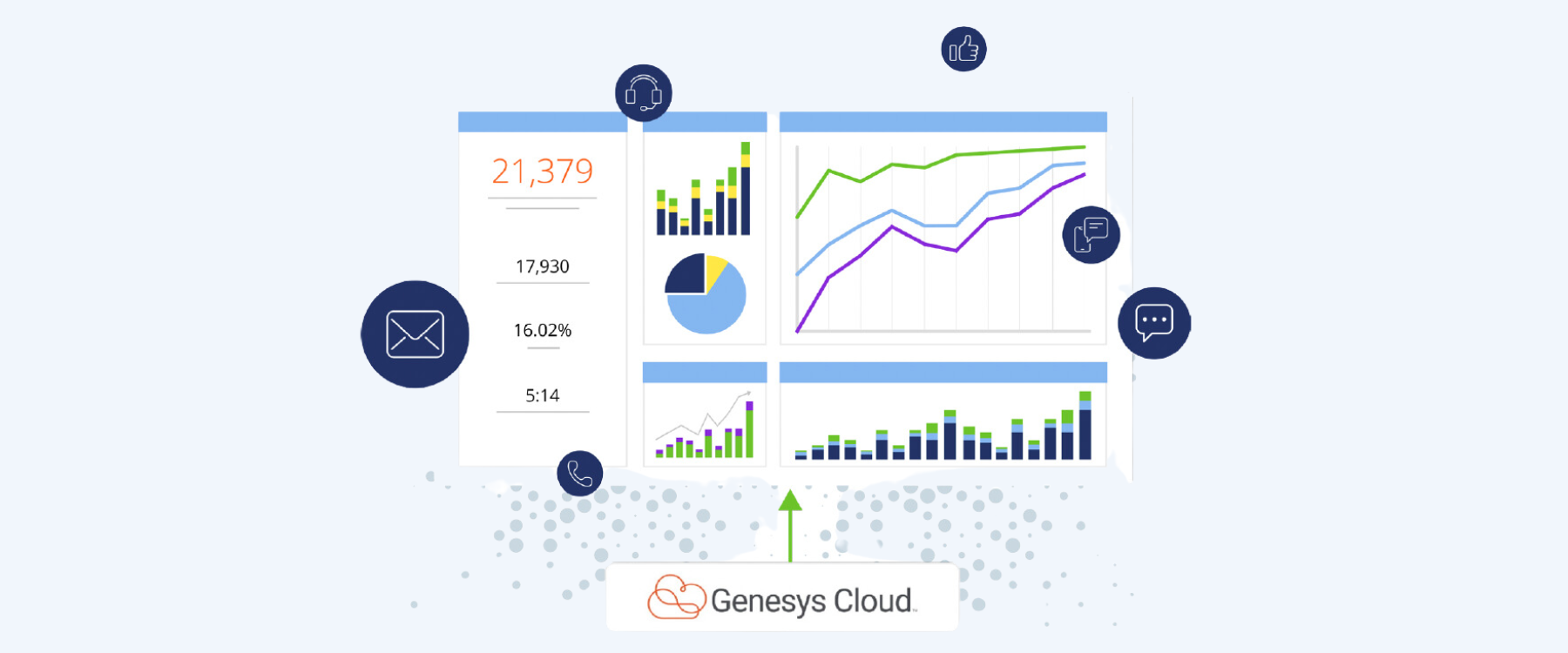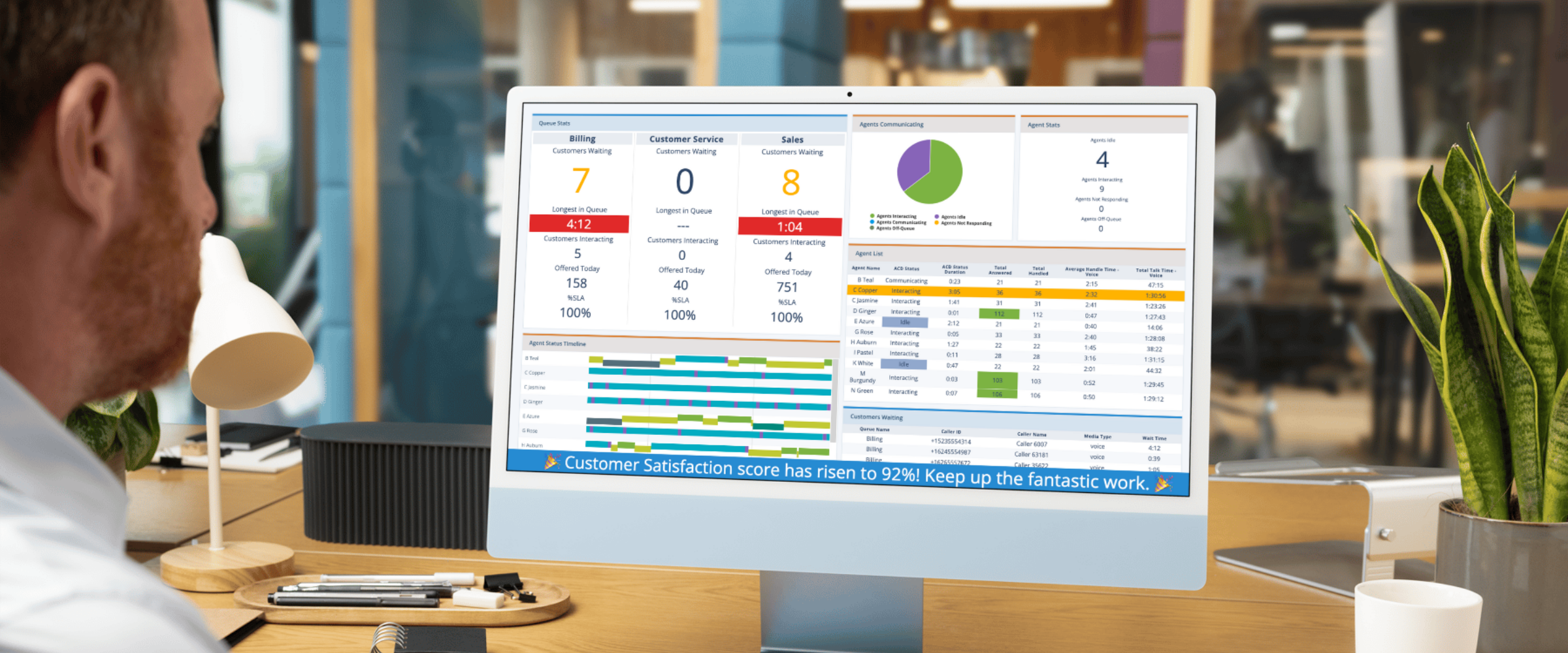Customers care about their interactions with your business more than ever before. By unearthing the customer data insights your business call center is already collecting, businesses can better meet customers’ expectations, and improve their overall customer experience. Call center analytics makes it easy to understand your customers.
Are your service-level agreements (SLA) being met? What are the root causes of churn? Who are your top-performing agents? Businesses are operating in a data-driven, customer-centric age, and having the right information from the right analytics can be a make or break for organizations.In this blog, we explore call center analytics and the importance of getting them right.
What Are Call Center Analytics?
Contact center and call center analytics refers to the process of pulling the raw data from your customer service tools, including phone, chat, and email, and processing these interactions into useful reports and dashboards that offer actionable insights.
Why Are Call Center Analytics Important?
As we touched on before, the power within the insights of call center analytics can really be a make or break for companies. So often contact centers struggle to grasp and adapt their strategies around a holistic view of contact center performances. This includes measuring performance across channels, product lines, and agents.
Call center managers sometimes feel they have to pull in huge data sets to get the full picture or settle for basic native analytics within their call center software packages. Understanding call center analytics software and how to use it to improve customer satisfaction (and loyalty) whilst improving processes that will increase your organization’s revenue will level up operations.
Types of Contact Center Analytics
Successful contact centers will have an understanding of the analytics that will best suit their needs as they look to monitor their operations. Each analytics software approach will have advantageous elements and limitations.
To really choose the best call center analytics, you will want to first understand the types of analytics available. We also want to make the note that it can be dependent upon the type of call center platform you are managing.
- Are you an inbound call center that provides support by handling customer inquiries that are brought to you via your customer through whatever channel they most want to use?
- Are you an outbound call center that hires your agents to make the first contact?
- Is your organization multichannel or omnichannel?
- Is your call center using software offering you the tools you need at a minimum?
- Does it have interactive voice response (IVR) routing, intelligent routing, automatic call distribution, automatic outbound dialing, switch functionality, and more?
Your business needs are unique and the analytics that will best serve it can look different at different stages.

Predictive Analytics
Predictive analytics allow you to assess and recognize ways to effectively communicate with your customers. This helps you optimize your sales, services, and interactions. They also help reduce average call handling time.
Cross Channel Analytics
This is one of the most important types of analytics. Cross-channel analytics allow you to identify and assess the different channels used by customers to interact with your organization. Once you learn more about the efficacy of these channels, it becomes easier for you to optimize customer interactions.
Speech Analytics
If you have voice-based call center processes then speech analytics is a must. These analytical touchpoints help your agents identify, understand, and analyze the customer’s requirements and insights through a conversation. They can help identify issues regarding the product, its operation, the system, the agents, or procedural problems.
Desktop Analytics
Desktop analytics help you track and monitor your employees’ desktop activity and the performance of systems. This allows you for organizational transparency and for you to gauge the performance of your agents and their systems for coaching and training opportunities.
Text Analytics
Text analytics is similar to voice or speech analytics but they involve understanding the customer’s requirements through text or written documents. Customer service channels that are social media interaction heavy benefit from this type of analytics.
Self-Service Interactions Analytics
If your call center has self-service automation these analytics are for you! They allow you to assess customer experiences in self-service channels such as the internet as well as interactive voice responses. With this information, you can identify methods to refine self-service applications and makes customer experiences more seamless.
2 Call Center Analytics Use Cases
So now that we have gone over the variety of types of analytics let’s delve into how they get applied in call center uses.
1. Understand Your Organization Enough to Set Goals
Predictive analytics are becoming increasingly important in the conversation about how business goals get shaped. We know that collecting data is important but having the right robust analytical tools help you identify the patterns in your data. And that inevitably helps you make more informed decisions surrounding the goals your organization has internally. From cross channel and desktop analytics you can get that complete picture of customer interactions and data that can help you be confident in the direction your organization is moving.
Having these insights at your fingertips with real-time analytics can be the difference in understanding the real layout of the call center landscape and can help your agents in real-time change their approaches, identify areas for opportunity, and understand their winning strategies. It can help your call center managers train, lead, and develop. It can help executive leadership understand what is within the grasp of achieving and what needs to be workshopped further.
2. Reduced Call Volume
Another great example of a use case for call center analytics is how to use advanced analytics for companies to conduct full, end-to-end analytics on the millions of customer data points, looking at text and call flow volumes to proactively identify potential improvements for a reduction in call volume. With the outcomes, companies can design solutions that enhance their customer’s user experience whilst prioritizing these sorts of individual measurements of feasibility and customer investment.
Agile approaches come in handy here when looking to roll out changes that are viable, tested, and iterated. As an example, IVR rapid simulations can accelerate testing and identify necessary refinements. Another example would be interactive dashboards that can measure impact by call types and customer types.
Answer questions like:
- How many customers are repeatedly calling?
- Why are they repeatedly calling?
- Is it a customer issue?
- Is it an agent issue?
- Is it a process issue?
- Is it a product issue?
Having clear, actionable insights can help illuminate the issues and identify the gaps and systemic issues that may be present. Simply reducing “unnecessary” repeat callers through analytics can reduce call volumes significantly.
How Brightmetrics Call Center Analytics and Reporting Can Help
Ask yourself, “Does my current contact center analytics platform make our customer data completely accessible?” “Does it also offer me the control and flexibility to slice and dice that data, diving deeper into our customer engagement reports?”
Your current platform’s native reporting tools may provide your management team with general metrics, like average queue time and historical call activity. But to truly understand daily team activity, as well as how your team is stacking up to performance goals, you may be having to pull data from an array of reports and piece them together to illustrate an overall story of your customer journey. Offering both predictive and cross-channel analytics, Brightmetrics delivers customer intelligence that directly drives the success of your contact center.
For example, with our Staff Forecasting reporting feature, make data-driven decisions and plan your staffing needs during peak hours of the day. Brightmetrics helps you become empowered with the breadth of data to make informed business decisions to deliver optimal customer experience & create better operational processes. With our drag and drop reporting tools, configure the visuals and metrics that are most important for you to see in the way that makes the most sense for you.

Agent Performance
As mentioned earlier when you look at how your agents are performing measuring the right KPIs will help companies quickly identify issues in real-time.
- Are agents waiting for connections due to low contact rates?
- Are your agents taking too much time between calls?
- Are call times long without resulting in a conversion?
- Are you agents in need of a knowledge resource center?
- Are there compliance issues that are going unresolved?
In multichannel or omnichannel call centers, agent efficiency is absolutely critical to profit margins. Brightmetrics helps you build fully customizable automated reports –including an agent scorecard– that will show you the detailed performance trends. It builds transparency within your organization for everyone to be on the same page. These advanced analytics help your individual agents with feedback and training opportunities. They help your managers support your agents, leading to less turnover. Ultimately, you are investing in building capable, motivated teams when you give them the data they need.
Tracking Trends Across Your Organization
The backbone of Brightmetrics business intelligence is deep call center analytics that provides remarkable insights using historical data to help you and your customer service team strategize and make better data-driven decisions. While our historical analytics is never more than an hour old, some situations call for up-to-the-minute metrics and reporting about your call center performance.
With REAL TIME Analytics™ we allow our customers to get a live feed of their agent activity and customer interactions. All of this helps you maintain a tight grasp of what is happening, what has happened, and what is going to happen.
Consistent Experiences
When it comes to historical and real-time analytics in a call center their foundation is the idea to give context to call data. You will see call volume monitored, as well as calls in queue and customer wait times. Most call center managers know one of the most important customer experience factors is wait time. Nobody wants to feel like they are wasting their precious time on hold. When you have access to these real-time analytics you can see easily identify long wait times, giving managers the opportunity to act to minimize the wait.
These procedures and systems are designed so that your customers are consistently getting the same (positive) experience no matter when they call and who they speak to, preserving their customer satisfaction and positive brand interaction.
Key Takeaways On Call Center Data Analytics
Here is the thing- companies love to talk about how much they care about their customers’ experiences but often overlook the easiest area to improve… their call centers. Think about how many organizations talk about identifying their customer pain points and leave out their call centers even though feedback shows consumers want efficient, responsive experiences. Think of how many companies talk about wanting to recruit top talent and retain their employees but do not understand the daily challenges of their call center agent.
The organizations that do it right have realized that to proactively differentiate themselves for their competitors they cannot get there without the help of advanced analytics. New technology, advanced analytical techniques, and methodologies are on the market (including Brightmetrics) and are built to help organizations achieve their customer service goals. The right call center analytical tools allow organizations to literally control their own future and we think that is extremely powerful.
FAQs About Call Center Analytics
What Are KPIs in Call Centers?
Call centers are designed with the objective of providing meaningful service to anyone who interacts with your organization. Key Performance Indicators (KPIs) help call center managers determine the success of their call center by measuring and tracking these interactions. KPIs also help highlight agent performance goals and benchmarks, providing a look at the customer experience your call center is delivering.
What Is Call Analysis?
Call analysis is the process of reviewing the words, duration, tone, and resolution of calls that are handled with call centers. This process is meant to improve experiences and processes for organizations.
What Is a Call Center Dashboard?
A call center dashboard is an “all-in-one” place where you can quickly identify the performance and actions of your call center team. With Brightmetrics, our dashboards are highly customizable to your goals. We offer call summary reports and drill-down features-we give you everything you need from high-level trends to nitty-gritty details to help you make intelligent business decisions. These dashboards should be giving you the insights you need to understand what is happening on the front line of your organization, what you need to do to help with workflow, and how to manage your call center operations.
How to Improve Call Center Analytics?
Looking to improve your call center analytics? Consistently review what you are measuring and why it matters to your organization. Act upon the insights you obtain from the analytics and experiment. Start with what you have! So often organizations are not doing enough with their current analytics tools. Starting out imperfectly is better than never starting.




